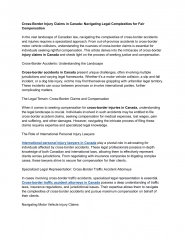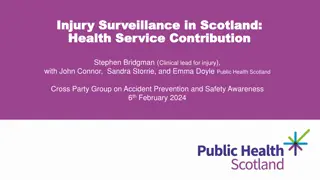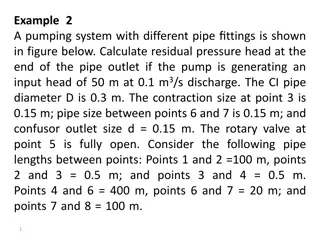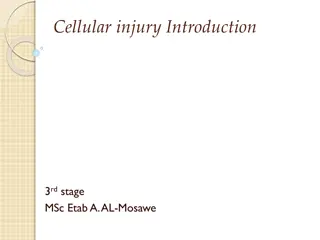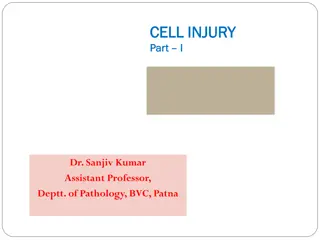
Head Injuries: Causes, Symptoms, and Treatment
Explore the definition, importance, and care of head injuries, including causes, symptoms, and types such as hematoma and concussion. Learn when medical attention is needed and prevention tips.
Download Presentation

Please find below an Image/Link to download the presentation.
The content on the website is provided AS IS for your information and personal use only. It may not be sold, licensed, or shared on other websites without obtaining consent from the author. If you encounter any issues during the download, it is possible that the publisher has removed the file from their server.
You are allowed to download the files provided on this website for personal or commercial use, subject to the condition that they are used lawfully. All files are the property of their respective owners.
The content on the website is provided AS IS for your information and personal use only. It may not be sold, licensed, or shared on other websites without obtaining consent from the author.
E N D
Presentation Transcript
www.studymafia.org Seminar On Head Injury Submitted To: www.studymafia.org www.studymafia.org Submitted By:
Table of Content 1. Introduction 2. Definition 3. Why Important 4. Why Care 5. Basic Anatomy 6. What causes a head injury? 7. What are the major types of head injuries? 8. What are the symptoms of a head injury? 9. When does a head injury require medical attention? 10. How is a head injury treated? 11. Prevention Tips
Definition Head injury is defined as any trauma to the head other than superficial injuries to the face (NICE 2017) Traumatic brain injury (TBI) is a non specific term describing blunt, penetration or blast injuries to the brain. TBI can be classified as mild, moderate or severe, typically based on the GCS Head injuries may be either closed or open. A closed head injury is any injury that doesn t break your skull. An open (penetrating) head injury is one in which something breaks your scalp and skull and enters your brain.
Why important? 1.4 million attendances in EDs England & Wales with head injuries 200,000 admitted to hospitals pa Of these 1 in 5 have skull fracture or evidence brain damage 95% people sustained head injury normal / minimally impaired conscious level (GCS >12) Lower GCS increased morbidity / mortality Although most recover without specialist intervention others experience long-term disability
Why Care? Head injury commonest cause of death / disability in people aged 1 40 years in UK High potential for poor outcome (especially if not recognised) Deaths occur at three points in time after injury: Immediately after the injury Within 2 hours after injury 3 weeks after injury
What causes a head injury? Head injuries caused by a blow to the head are usually associated with: motor vehicle accidents falls physical assaults sports-related accidents
What are the major types of head injuries? Hematoma Hemorrhage Concussion Edema Skull fracture Diffuse axonal injury
Hematoma A hematoma is a collection, or clotting, of blood outside the blood vessels. It can be very serious if a hematoma occurs in the brain. The clotting can lead to pressure building up inside your skull. This can cause you to lose consciousness or result in permanent brain damage.
Hemorrhage A hemorrhage is uncontrolled bleeding. There can be bleeding in the space around your brain, called subarachnoid hemorrhage, or bleeding within your brain tissue, called intracerebral hemorrhage. Subarachnoid hemorrhages often cause headaches and vomiting. The severity of intracerebral hemorrhages depends on how much bleeding there is, but over time any amount of blood can cause pressure buildup.
Concussion A concussion occurs when the impact on the head is severe enough to cause brain injury. It s thought to be the result of the brain hitting against the hard walls of your skull or the forces of sudden acceleration and deceleration. Generally speaking, the loss of function associated with a concussion is temporary. However, repeated concussions can eventually lead to permanent damage.
Edema Any brain injury can lead to edema, or swelling. Many injuries cause swelling of the surrounding tissues, but it s more serious when it occurs in your brain. Your skull can t stretch to accommodate the swelling. This leads to pressure buildup in your brain, causing your brain to press against your skull.
Skull fracture Unlike most bones in your body, your skull doesn t have bone marrow. This makes the skull very strong and difficult to break. A broken skull is unable to absorb the impact of a blow, making it more likely that there ll also be damage to your brain.
Diffuse axonal injury A diffuse axonal injury (sheer injury) is an injury to the brain that doesn t cause bleeding but does damage the brain cells. The damage to the brain cells results in them not being able to function. It can also result in swelling, causing more damage. Though it isn t as outwardly visible as other forms of brain injury, a diffuse axonal injury is one of the most dangerous types of head injuries.
What are the symptoms of a head injury? Common symptoms of a minor head injury include: a headache lightheadedness a spinning sensation mild confusion nausea temporary ringing in the ears
When does a head injury require medical attention? In particular, you should always seek immediate medical attention if you experience any of the following: loss of consciousness confusion disorientation
How is a head injury diagnosed? One of the first ways your doctor will assess your head injury is with the Glasgow Coma Scale (GCS). The GCS is a 15-point test that assesses your mental status. A high GCS score indicates a less severe injury. Your doctor will need to know the circumstances of your injury. Often, if you ve had a head injury, you won t remember the details of the accident. If it s possible, you should bring someone with you who witnessed the accident. It will be important for your doctor to determine if you lost consciousness and for how long if you did.
How is a head injury treated? The treatment for severe head injuries can include: Medication Surgery Rehabilitation
Whats to be expected in the long term? The outlook depends on the severity of your injury. Most people who ve had minor head injuries experience no lasting consequences. People who ve had serious head injuries may face permanent changes in their personality, physical abilities, and ability to think. Severe head injuries in childhood can be particularly concerning. It s generally thought developing brains are susceptible to injuries. There s ongoing research studying this issue. Your healthcare team will work with you to ensure that you have as full of a recovery as possible.
Sports and Recreation Head Injury Prevention Tips For specific sports, 100 percent of the time, buy and use helmets or protective headgear approved by the American Society for Testing and Materials (ASTM). Supervise younger children at all times. Do not allow younger children to use sporting equipment or play sports unsuitable for their age. Avoid the use of playgrounds with hard surfaces. Follow all rules and warning signs at water parks, swimming pools and public beaches. Do not dive in water less than 12 feet deep or in above-ground pools. Check the depth and check for debris in the water before diving. Wear appropriate clothing for the sport.
References Google.com Wikipedia.org Studymafia.org

